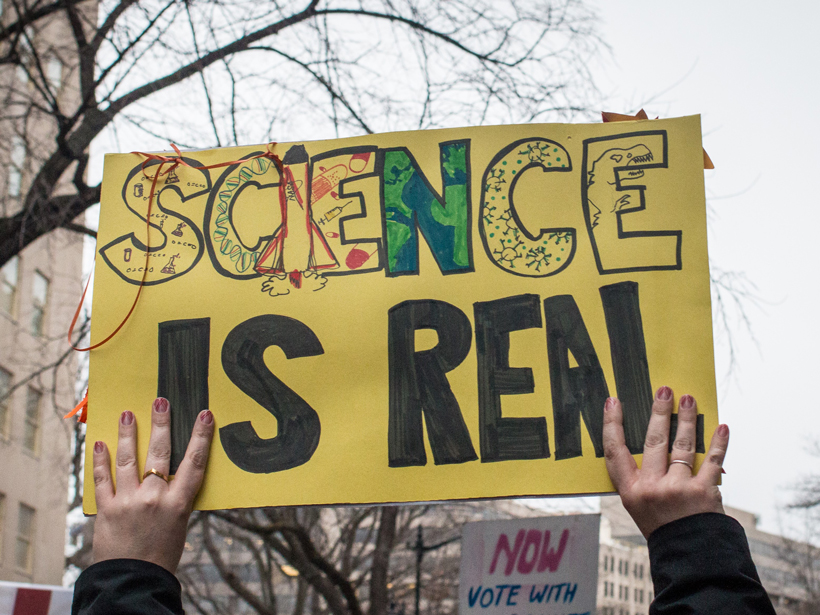On the Sunday before last year’s American Geophysical Union (AGU) Fall Meeting—about a month after the U.S. elections—I found myself in a windowless room, deep in the basement of the San Francisco Marriot Marquis. It was 8:00 a.m., and I was shaking off jet lag to attend a science communications workshop hosted by AGU’s Sharing Science program.
Communications, in this context, means talking about science to people who aren’t scientists. The workshop covered three topics: interacting with the general public, which I love; talking to journalists, which is what drew me; and interactions with politicians. I figured I’d zone out through that last bit.
But that isn’t quite how things turned out.
A Eureka Moment
Let’s back up a bit. Even when I was a postdoc in the Washington, D. C., area, almost 2 decades ago, I avoided politics like the plague.
This disengagement isn’t just unreasoned distaste. Some years ago, prompted by a request from a scientist I greatly admire to sign a policy statement I wholeheartedly agreed with, I thought long and hard about whether to engage in political discourse as a scientist.
In the end, after seeing a timely and terrific set of talks, I did not sign that statement. Instead, I settled on the idea that science can tell us what is true but not what to do—that policy might be grounded in truth but ultimately reflects values.
That principle served me well enough for a decade, even in the face of growing unease about increasingly counterfactual arguments against the increasingly deep understanding of climate change. But times have changed, and it’s become unnervingly normal to advance political agendas by denying the truths that science provides.
Even if I’m unwilling to advocate for particular policies in my role as a scientist, I am more than ready to advocate for what we do.
Our democratic system means that I expect power to be mutable. But I also expect the rules to stay more or less the same, and these days that’s not such a sure bet.
Sitting in that basement room, listening to the people who argue for our work to the people who use what we learn (and pay for our curiosity), I knew that even if I’m unwilling to advocate for particular policies in my role as a scientist, I am more than ready to advocate for what we do and to make the case for stability, intellectual freedom, and openness in how we do it.
A Visit to Congress
With this readiness to advocate, I took advantage of a trip to Washington earlier this year to spend a day of my own time visiting members of Congress.
The visits were arranged by AGU’s public affairs staff, the same people who run AGU’s Congressional Visits Days. In the weeks before the trip, the staff helped me craft a message, then refine a script with stories and concrete requests. They identified whom I could meet with and what committee memberships or legislative sponsorships would make the visit most relevant. They joined me on those visits, guiding me through a bewildering building and an even more bewildering social world.
The legislative side of the federal government is like another country: unfamiliar, sometimes uncomfortable, but easy enough to get the hang of, once I had dusted off my interview suit.
Capitol Hill runs on young people. Most staff are the age of graduate students, the really senior staff about as old as postdocs. Nonetheless, it quickly becomes apparent that these are smart people with knowledge and power.
Anecdotes make facts personal—and people, after all, are far more important than ideas.
Some social customs take getting used to: In everyday conversation, it would be rude to make a request without establishing a connection, but on the Hill “the ask” is the first thing on the table because this gives your hosts the chance to calibrate who you are and how to respond to you.
One-off stories have little value in scientific arguments, but they are gold in congressional offices. That’s partly because time is short (most visits last 30 minutes or less). But it’s also because anecdotes make facts personal—and people, after all, are far more important than ideas.
My biggest surprise, however, was learning firsthand how hard congressional staff work to find common ground. For my visit, AGU had arranged meetings with representatives from both political parties, guaranteeing that some of the people I met would have political viewpoints different than my own. And yet every single staff member went out of his or her way to hear what I had to say, respond thoughtfully, and identify one or more points on which our agendas aligned.
No Landscape Is Permanent
Of course, no single visit by a single scientist is going to change any legislator’s well-developed policy stance. Does that mean the visits are pointless or self-indulgent?
I don’t think so. On the most basic level, politicians respond to public pressure and opinion, and newly engaged, vocal, and organized communities can be valuable support or formidable opponents.
The landscape right now might seem so permanent, but then there’s the Grand Canyon…
More fundamentally, politicians have to triangulate an enormous range of priorities. The fate of Earth science is rarely the most pressing or compelling. And yet they listen, and I’d like to think that positions might change.
Musing on the way home from my congressional visit, I couldn’t shake the image of a stream running over rocks. The landscape right now might seem so permanent, but then there’s the Grand Canyon…
—Robert Pincus (email: [email protected]), University of Colorado Boulder
Citation:
Pincus, R. (2017), Acquiring a taste for advocacy, Eos, 98, https://doi.org/10.1029/2017EO072221. Published on 20 April 2017.
Text © 2017. The authors. CC BY-NC-ND 3.0
Except where otherwise noted, images are subject to copyright. Any reuse without express permission from the copyright owner is prohibited.

